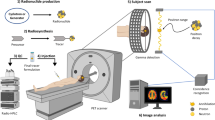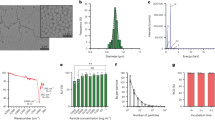Abstract
Owing to the diversity of cancer types and the spatiotemporal heterogeneity of tumour signals, high-resolution imaging of occult malignancy is challenging. 18F-fluorodeoxyglucose positron emission tomography allows for near-universal cancer detection, yet in many clinical scenarios it is hampered by false positives. Here, we report a method for the amplification of imaging contrast in tumours via the temporal integration of the imaging signals triggered by tumour acidosis. This method exploits the catastrophic disassembly, at the acidic pH of the tumour milieu, of pH-sensitive positron-emitting neutral copolymer micelles into polycationic polymers, which are then internalized and retained by the cancer cells. Positron emission tomography imaging of the 64Cu-labelled polymers detected small occult tumours (10–20 mm3) in the brain, head, neck and breast of mice at much higher contrast than 18F-fluorodeoxyglucose, 11C-methionine and pH-insensitive 64Cu-labelled nanoparticles. We also show that the pH-sensitive probes reduce false positive detection rates in a mouse model of non-cancerous lipopolysaccharide-induced inflammation. This macromolecular strategy for integrating tumour acidosis should enable improved cancer detection, surveillance and staging.
This is a preview of subscription content, access via your institution
Access options
Access Nature and 54 other Nature Portfolio journals
Get Nature+, our best-value online-access subscription
$29.99 / 30 days
cancel any time
Subscribe to this journal
Receive 12 digital issues and online access to articles
$99.00 per year
only $8.25 per issue
Buy this article
- Purchase on Springer Link
- Instant access to full article PDF
Prices may be subject to local taxes which are calculated during checkout







Similar content being viewed by others
Data availability
The authors declare that the main data supporting the results in this study are available within the paper and its Supplementary Information. The raw and analysed datasets generated during the study are available for research purposes from the corresponding authors on reasonable request.
References
Vogelstein, B. et al. Cancer genome landscapes. Science 339, 1546–1558 (2013).
Jacobs, T. W., Gown, A. M., Yaziji, H., Barnes, M. J. & Schnitt, S. J. HER-2/neu protein expression in breast cancer evaluated by immunohistochemistry. A study of interlaboratory agreement. Am. J. Clin. Pathol. 113, 251–258 (2000).
Paik, S. et al. HER2 and choice of adjuvant chemotherapy for invasive breast cancer: National Surgical Adjuvant Breast and Bowel Project Protocol B-15. J. Natl Cancer Inst. 92, 1991–1998 (2000).
Hanahan, D. & Weinberg, R. A. Hallmarks of cancer: the next generation. Cell 144, 646–674 (2011).
Heiden, M. G. V., Cantley, L. C. & Thompson, C. B. Understanding the Warburg effect: the metabolic requirements of cell proliferation. Science 324, 1029–1033 (2009).
Hensley, C. T. et al. Metabolic heterogeneity in human lung tumours. Cell 164, 681–694 (2016).
Zhu, A., Lee, D. & Shim, H. Metabolic positron emission tomography imaging in cancer detection and therapy response. Semin. Oncol. 38, 55–69 (2011).
Som, P. et al. A fluorinated glucose analog, 2-fluoro-2-deoxy-d-glucose (F-18): nontoxic tracer for rapid tumour detection. J. Nucl. Med. 21, 670–675 (1980).
Cook, G. J., Wegner, E. A. & Fogelman, I. Pitfalls and artifacts in 18FDG PET and PET/CT oncologic imaging. Semin. Nucl. Med. 34, 122–133 (2004).
Purohit, B. S. et al. FDG-PET/CT pitfalls in oncological head and neck imaging. Insights Imaging 5, 585–602 (2014).
Truong, M. T., Viswanathan, C., Carter, B. W., Mawlawi, O. & Marom, E. M. PET/CT in the thorax: pitfalls. Radiol. Clin. North Am. 52, 17–25 (2014).
Culverwell, A. D., Scarsbrook, A. F. & Chowdhury, F. U. False-positive uptake on 2-[18F]-fluoro-2-deoxy-d-glucose (FDG) positron-emission tomography/computed tomography (PET/CT) in oncological imaging. Clin. Radiol. 66, 366–382 (2011).
Truong, M. T. et al. Integrated positron emission tomography/computed tomography in patients with non-small cell lung cancer: normal variants and pitfalls. J. Comput. Assist. Tomogr. 29, 205–209 (2005).
Bhargava, P., Rahman, S. & Wendt, J. Atlas of confounding factors in head and neck PET/CT imaging. Clin. Nucl. Med. 36, e20–e29 (2011).
Blodgett, T. M., Mehta, A. S., Laymon, C. M., Carney, J. & Townsend, D. W. PET/CT artifacts. Clin. Imaging 35, 49–63 (2011).
Fukui, M. B. et al. Combined PET-CT in the head and neck: part 2. Diagnostic uses and pitfalls of oncologic imaging. Radiographics 25, 913–930 (2005).
Cohade, C., Mourtzikos, K. A. & Wahl, R. L. “USA-Fat”: prevalence is related to ambient outdoor temperature—evaluation with 18F-FDG PET/CT. J. Nucl. Med. 44, 1267–1270 (2003).
Perkins, A. C., Mshelia, D. S., Symonds, M. E. & Sathekge, M. Prevalence and pattern of brown adipose tissue distribution of 18F-FDG in patients undergoing PET-CT in a subtropical climatic zone. Nucl. Med. Commun. 34, 168–174 (2013).
Gould, M. K., Maclean, C. C., Kuschner, W. G., Rydzak, C. E. & Owens, D. K. Accuracy of positron emission tomography for diagnosis of pulmonary nodules and mass lesions: a meta-analysis. J. Am. Med. Assoc. 285, 914–924 (2001).
Harvey, R. J. et al. PET/CT in the assessment of previously treated skull base malignancies. Head Neck 32, 76–84 (2010).
Schoder, H. in Nuclear Oncology: Pathophysiology and Clinical Applications (eds Strauss, H. W., Mariani, G., Volterrani, D. & Larson, S. M.) 269–295 (Springer, 2013).
Castaigne, C., Muylle, K. & Flamen, P. in Head and Neck Cancer Imaging (ed. Hermans, R.) 329–343 (Springer, 2006).
Schmalfuss, I. in Head and Neck Cancer Imaging (ed. Hermans, R.) 363–385 (Springer, 2012).
Zhao, T. et al. A transistor-like pH nanoprobe for tumour detection and image-guided surgery. Nat. Biomed. Eng. 1, 0006 (2016).
Tsarevsky, N. V. & Matyjaszewski, K. “Green” atom transfer radical polymerization: from process design to preparation of well-defined environmentally friendly polymeric materials. Chem. Rev. 107, 2270–2299 (2007).
Lopez-Fontal, E., Milanesi, L. & Tomas, S. Multivalence cooperativity leading to “all-or-nothing” assembly: the case of nucleation-growth in supramolecular polymers. Chem. Sci. 7, 4468–4475 (2016).
Williamson, J. R. Cooperativity in macromolecular assembly. Nat. Chem. Biol. 4, 458–465 (2008).
Moghimi, S. M. & Szebeni, J. Stealth liposomes and long circulating nanoparticles: critical issues in pharmacokinetics, opsonization and protein-binding properties. Prog. Lipid Res. 42, 463–478 (2003).
Hess, S., Hansson, S. H., Pedersen, K. T., Basu, S. & Hoilund-Carlsen, P. F. FDG-PET/CT in infectious and inflammatory diseases. PET Clin. 9, 497–519 (2014).
Wen, P. Y. & Kesari, S. Malignant gliomas in adults. N. Engl. J. Med. 359, 492–507 (2008).
Omuro, A. & DeAngelis, L. M. Glioblastoma and other malignant gliomas: a clinical review. J. Am. Med. Assoc. 310, 1842–1850 (2013).
Fink, J. R., Muzi, M., Peck, M. & Krohn, K. A. Multimodality brain tumor imaging: MR imaging, PET, and PET/MR Imaging. J. Nucl. Med. 56, 1554–1561 (2015).
Becherer, A. et al. Brain tumour imaging with PET: a comparison between [18F]fluorodopa and [11C]methionine. Eur. J. Nucl. Med. Mol. Imaging 30, 1561–1567 (2003).
Glaudemans, A. W. et al. Value of 11C-methionine PET in imaging brain tumours and metastases. Eur. J. Nucl. Med. Mol. Imaging 40, 615–635 (2013).
Juhasz, C., Dwivedi, S., Kamson, D. O., Michelhaugh, S. K. & Mittal, S. Comparison of amino acid positron emission tomographic radiotracers for molecular imaging of primary and metastatic brain tumours. Mol. Imaging 13, 1–16 (2014).
Harris, R. J. et al. pH-weighted molecular imaging of gliomas using amine chemical exchange saturation transfer MRI. Neuro-Oncol. 17, 1514–1524 (2015).
Thews, O. et al. Activation of P-glycoprotein (Pgp)-mediated drug efflux by extracellular acidosis: in vivo imaging with 68Ga-labelled PET tracer. Eur. J. Nucl. Med. Mol. Imaging 37, 1935–1942 (2010).
Demoin, D. W. et al. PET imaging of extracellular pH in tumours with 64Cu- and 18F-labeled pHLIP peptides: a structure–activity optimization study. Bioconjug. Chem. 27, 2014–2023 (2016).
Vavere, A. L. et al. A novel technology for the imaging of acidic prostate tumours by positron emission tomography. Cancer Res. 69, 4510–4516 (2009).
Weerakkody, D. et al. Family of pH (low) insertion peptides for tumour targeting. Proc. Natl Acad. Sci. USA 110, 5834–5839 (2013).
Urano, Y. et al. Selective molecular imaging of viable cancer cells with pH-activatable fluorescence probes. Nat. Med. 15, 104–109 (2009).
Gillies, R. J., Liu, Z. & Bhujwalla, Z. P-31-Mrs measurements of extracellular Ph of tumours using 3-aminopropylphosphonate. Am. J. Physiol. 267, C195–C203 (1994).
Gillies, R. J., Raghunand, N., Garcia-Martin, M. L. & Gatenby, R. A. PH imaging. IEEE Eng. Med. Biol. Mag. 23, 57–64 (2004).
Volk, T., Jahde, E., Fortmeyer, H. P., Glusenkamp, K. H. & Rajewsky, M. F. pH in human tumour xenografts: effect of intravenous administration of glucose. Br. J. Cancer 68, 492–500 (1993).
Li, Y., Wang, Y., Huang, G. & Gao, J. Cooperativity principles in self-assembled nanomedicine. Chem. Rev. 118, 5359–5391 (2018).
Ma, X. et al. Ultra-pH-sensitive nanoprobe library with broad pH tunability and fluorescence emissions. J. Am. Chem. Soc. 136, 11085–11092 (2014).
Wang, Y. et al. A nanoparticle-based strategy for the imaging of a broad range of tumours by nonlinear amplification of microenvironment signals. Nat. Mater. 13, 204–212 (2014).
Blanco, E. et al. β-lapachone micellar nanotherapeutics for non-small cell lung cancer therapy. Cancer Res. 70, 3896–3904 (2010).
Fin, L., Bailly, P., Daouk, J. & Meyer, M. E. A practical way to improve contrast-to-noise ratio and quantitation for statistical-based iterative reconstruction in whole-body PET imaging. Med. Phys. 36, 3072–3079 (2009).
Yan, J., Schaefferkoette, J., Conti, M. & Townsend, D. A method to assess image quality for low-dose PET: analysis of SNR, CNR, bias and image noise. Cancer Imaging 16, 26 (2016).
Acknowledgements
We thank R. Bachoo for the original 73C cancer cells, Y. Li and Q. Feng for helpful discussions. This work is supported by the National Institutes of Health (R01CA192221 and R01CA211930) and Cancer Prevention and Research Institute of Texas (RP180343). The animal imaging work was supported by a University of Texas Southwestern Small Animal Imaging Resource Grant (U24 CA126608), and radiochemistry and PET imaging were supported by a Simmons Cancer Center Support Grant (P30 CA142543) and CPRIT Grant (RP110771) to X.S.
Author information
Authors and Affiliations
Contributions
G.Huang, B.D.S. and J.G. are responsible for all of the phases of the research. G.Huang performed all of the experiments and analyses. T.Z. assisted the polymer synthesis and FDG-PET imaging. C.W. performed the confocal imaging on cell uptake of nanoprobes. K.N. ran the PET/CT scan and imaging analysis. Y.X. performed the initial radiolabelling experiments. X.G. and Y.W. prepared the 73C brain tumour model. G.Hao helped with 64Cu coupling with UPS nanoprobes. W.-P.G. assisted with the analysis of the 73C brain tumour study. X.S. helped design the FDG and 64Cu PET experiments.
Corresponding authors
Ethics declarations
Competing interests
B.D.S. and J.G. are scientific co-founders and scientific advisors of OncoNano Medicine, Inc. G.Huang is a scientific advisor for OncoNano Medicine, Inc. T.Z. is currently an employee of OncoNano Medicine, Inc.
Additional information
Publisher’s note: Springer Nature remains neutral with regard to jurisdictional claims in published maps and institutional affiliations.
Supplementary information
Supplementary Information
Supplementary figures, tables and video captions.
Supplementary Video 1
3D rotation of the PET/CT imaging of HN5 tumour-bearing mice 24 h post-injection of 64Cu-UPS6.9.
Supplementary Video 2
3D rotation of the PET/CT imaging of HN5 tumour-bearing mice 1 h post-injection of FDG.
Supplementary Video 3
3D rotation of the PET/CT imaging of HN5 tumour-bearing mice 24 h post-injection of 64Cu-PEG-PLA.
Rights and permissions
About this article
Cite this article
Huang, G., Zhao, T., Wang, C. et al. PET imaging of occult tumours by temporal integration of tumour-acidosis signals from pH-sensitive 64Cu-labelled polymers. Nat Biomed Eng 4, 314–324 (2020). https://doi.org/10.1038/s41551-019-0416-1
Received:
Accepted:
Published:
Issue Date:
DOI: https://doi.org/10.1038/s41551-019-0416-1
This article is cited by
-
Severely polarized extracellular acidity around tumour cells
Nature Biomedical Engineering (2024)
-
How protons pave the way to aggressive cancers
Nature Reviews Cancer (2023)
-
Radiolabeled nanomaterials for biomedical applications: radiopharmacy in the era of nanotechnology
EJNMMI Radiopharmacy and Chemistry (2022)
-
Engineered bioorthogonal POLY-PROTAC nanoparticles for tumour-specific protein degradation and precise cancer therapy
Nature Communications (2022)
-
Microenvironment-triggered multimodal precision diagnostics
Nature Materials (2021)



